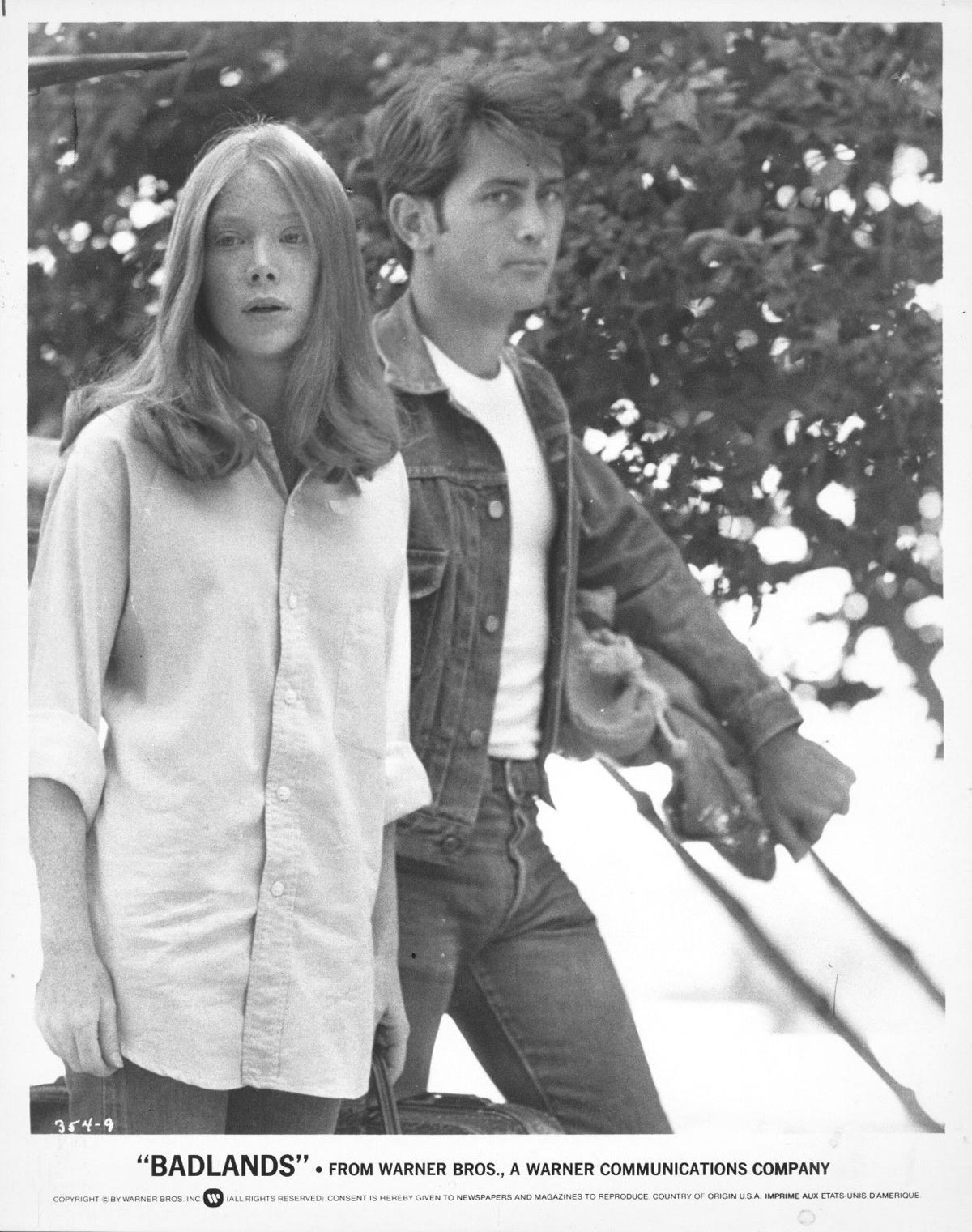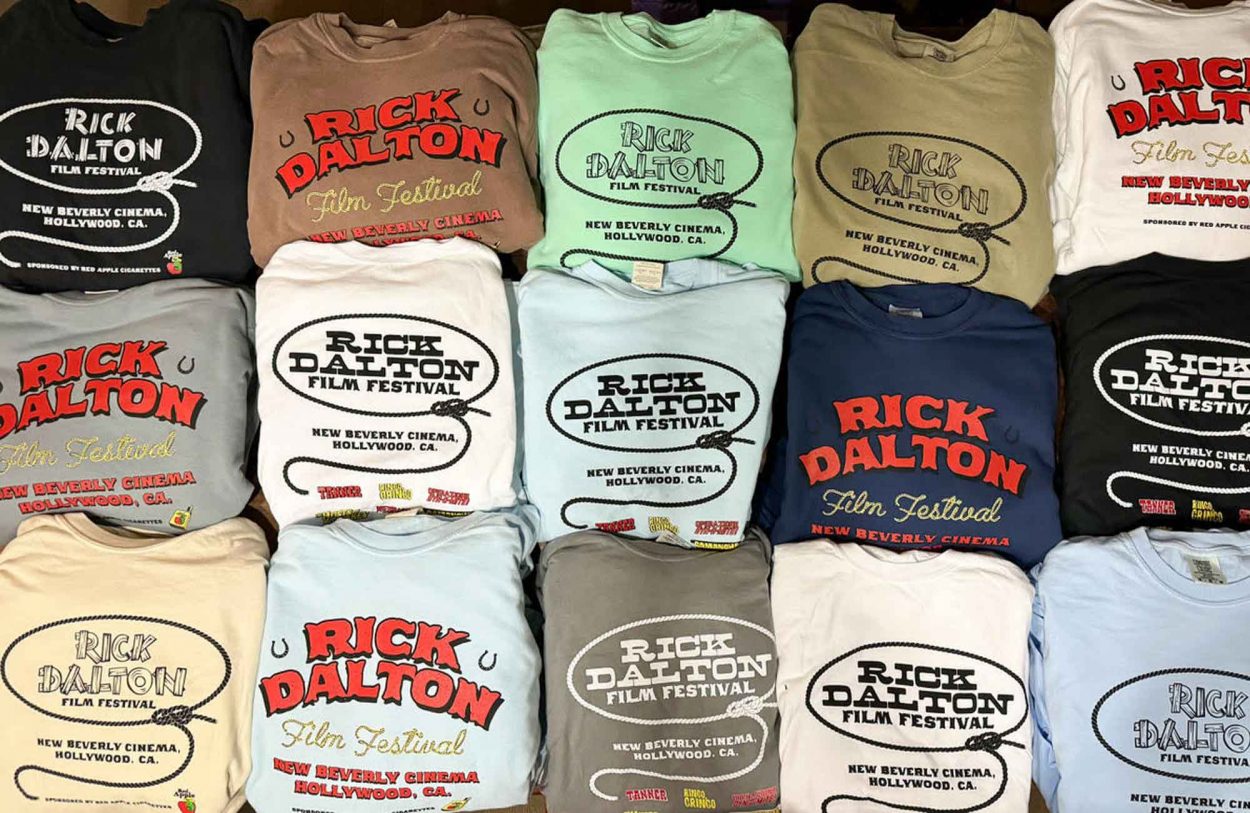“Where would I be this very moment if Kit had never met me? Or killed anybody? This very moment. If my Mom had never met my Dad? If she’d of never died? And what’s the man I’ll marry going to look like? What’s he doing right this minute? Is he thinking about me now, by some coincidence, even though he doesn’t know me? Does it show on his face?”
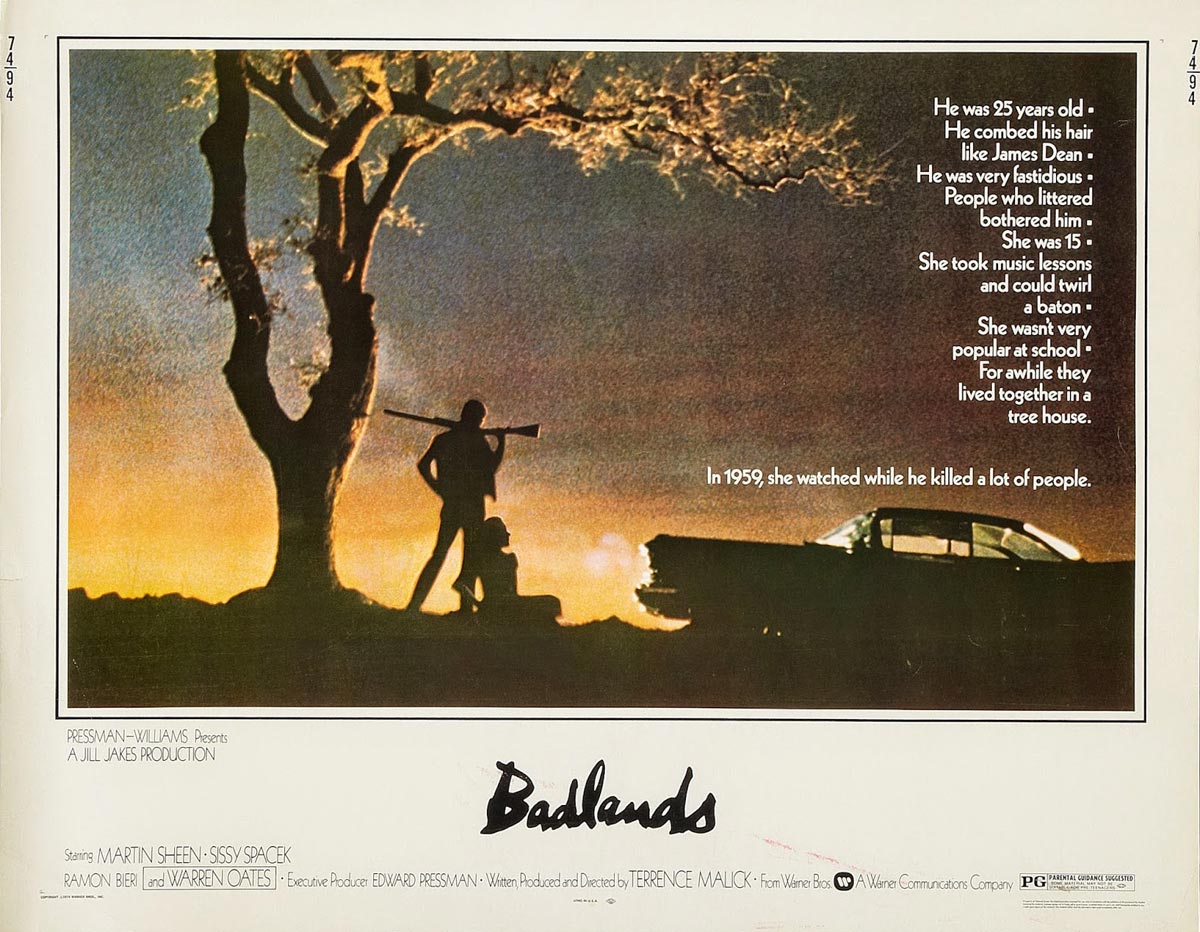
I saw Badlands on TV when I was in middle school. At least I think I saw it. I was 13. I remember scenes, or I remember the memory of seeing scenes, because I had been staying home from school for a week, sick, only I wasn’t sick, I was delirious. I was having an awful few months and I hadn’t been sleeping. My insomnia and nerves were so terrible that I was walking around in a dazed, somnambulant state and watching movies would get my mind off whatever was troubling me. I liked wandering around outside but I was too tired so I would curl up on the couch and sleep in the day, eyes opening and closing to the TV and to movies, images melding into daytime and into dreams. Badlands feels swirled in my own dreams, younger and older, but during those bad months, I wasn’t dreaming much.
I didn’t know why I couldn’t sleep and it frightened me. I didn’t like being inside my own head, sinking into my thoughts. Movies were a way to mix up my mind, glazing my brain from things I didn’t want to think about and buoying my spirits. Often my own thoughts and the images I was watching would merge – this is my life – and if you’re tired enough (or maybe crazy, and lack of sleep can make you crazy), you are in a movie. That’s why Badlands felt (or feels) a part of that beautiful, disturbing escape, an escape from thinking my raw thoughts too much. It’s like the frames of Badlands were snapshots I had taken in my own mind. But of course those were Terrence Malick’s snapshots. He handed them over to me, and to everyone else haunted by the picture. Badlands is a powerful thing.
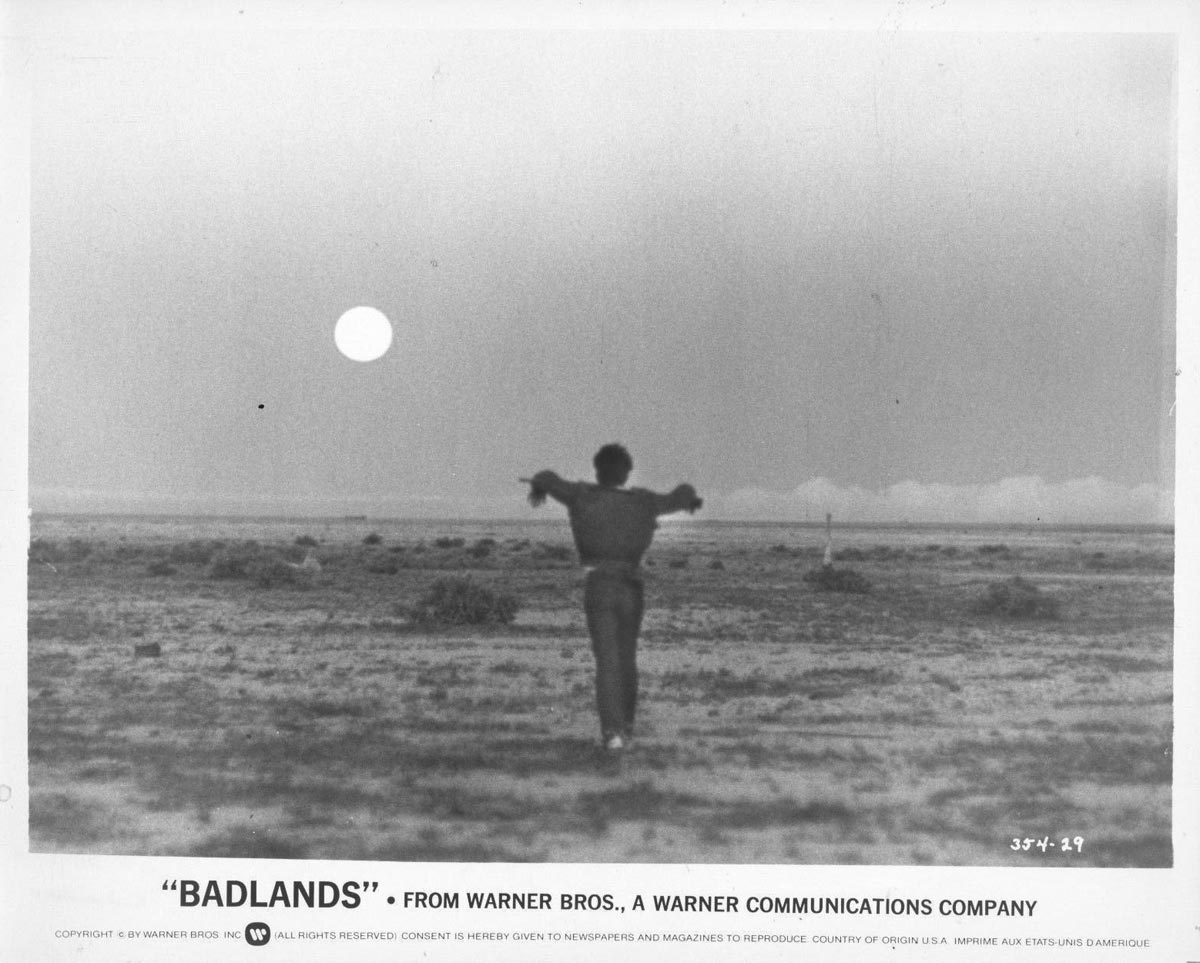
And thoughts are powerful when you’re young. They start to really expand and flower when you’re 12 or 13; your brain is still growing. Those thoughts can seem strange, exciting and wonderful, but sometimes disturbing – adolescence makes you jump to different places, feel new sensations, and experience a darkness that makes you wonder if the odd stuff coming to you are just impressions running through your mind, or if you actually think that way. Your curiosity is like the girl in Badlands – Sissy Spacek’s Holly looking through the pictures in her dad’s stereopticon and wondering about what could have happened had her circumstances been different. What her future would become. And you lay awake and worry – worry how Holly was worried about tossing her sick catfish into the yard. Was that a terrible thing to do? You think of living in different cities, you think of running away, meeting a boy, you think of driving off in your parent’s car in the middle of the night. I tried that – driving the car before I knew how to. I backed it into a large pine tree.
Those thoughts and that car and that pine tree make me think of watching Badlands. But this is all a fevered memory and my recall may be wrong. Maybe I’m imprinting a future impression on the past and how I saw Badlands because I know I watched Badlands in full, in a conscience state, when I was a little older, when it became a favorite movie. But the first viewing – maybe that’s like a memory the way you look at a photograph of yourself as a kid and wonder if you really do remember that trip to the beach. You’re gathering information based on a picture you’ve looked at numerous times. Would you remember anything if you didn’t have that picture? Martin Sheen’s Kit and Spacek’s Holly were pictures, music and voices I heard, I think, in and out of consciousness on that couch. Kit’s good-looking, charming, sometimes a little dumb, casually cold-blooded “character” (he really wants to be a character) and Holly’s strange, ethereal beauty, her questionable lack of concern for others’ deaths (we know Kit doesn’t mind) save for her catfish and briefly, her own dad (played by Warren Oates), and her flowery narration are firmly planted in my mind. It’s real to me and yet, totally fantastical to me. Kit and Holly’s own mythmaking rolls into my own movie mythmaking and even a few events in my young life.
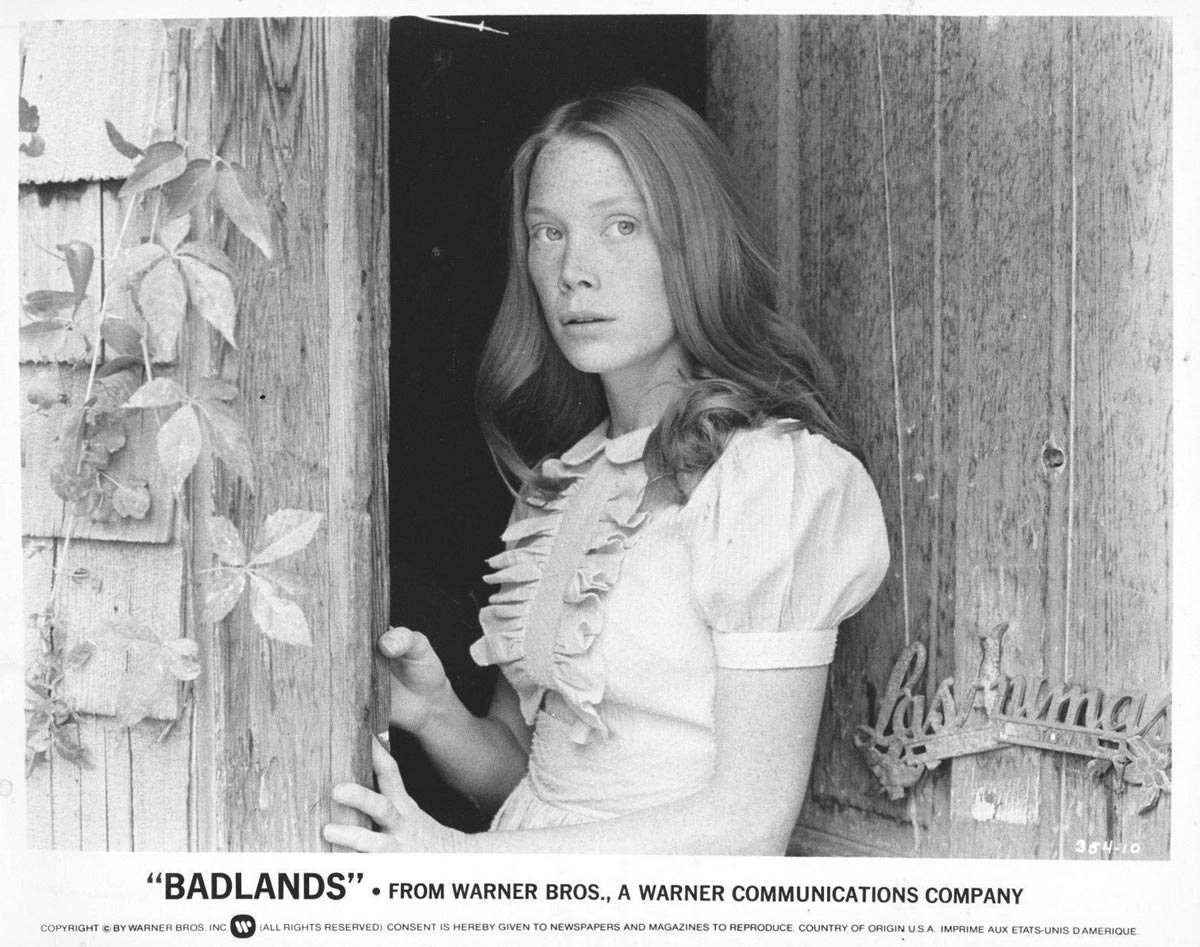
But did I see this? I’m sure I’d heard of Charlie Starkweather and Caril Ann Fugate, the real life lovers the picture was inspired from. During two deadly winter months from 1957-58, 19-year-old Starkweather murdered eleven people in the states of Nebraska and Wyoming with his 14-year-old girlfriend Caril in tow. Was she a captive, an accomplice or caught up in a crazy romantic delusion? He was put to death, she was given life (she served 17 years). Reporters, the public and mostly teens were fascinated by this duo and this boy who reminded them more of a nihilistic James Dean than a boogeyman, though he certainly scared a lot of people. The couple is as mythically American as Bonnie and Clyde, only more terrifying and senseless, killing and stealing cars and grabbing items from houses in the late 1950’s. They weren’t modern day Robin Hoods robbing banks during the depression; they were rebels without a cause taken to the extreme of teenage rebellion and alienation. But like Bonnie and Clyde, they looked good. As such, they were made for the movies.
Even Charlie’s name, Starkweather, conjures up a cinematic image, a temperature, a chill. Leaving their imprint on popular culture from Bruce Springsteen to The Sadist to a Naked City episode, “A Case Study of Two Savages,” starring Rip Torn and Tuesday Weld, the dark romance of the leather-clad bad boy stuck – it’s something kids gravitate towards, and even with Starkweather’s brutal murders (including a baby), he’s glamorized – kids often glide over the horrifying, focusing on the They Live By Night lovers-on-the-run allure (which could have inspired Starkweather, the second Nicholas Ray movie he may have crafted himself on next to Rebel Without a Cause). Uniquely, however, save for their loveliness, Malick’s Badlands doesn’t glamorize the pair, not in the usual way, even as rapturously beautiful as the picture is. The killers are softened, yes, but their murders, though awful, are less heinous, and their disconnect towards death is merged with the heart-aching beauty and the wonder of nature. You’re not sure if you feel for them, if you feel for how lost and delusional they are, or if you feel for the idyllic world they’re hoping for – the stunning world Malick is placing around them. Because we hope and hoped for that world too, we even ache for it.
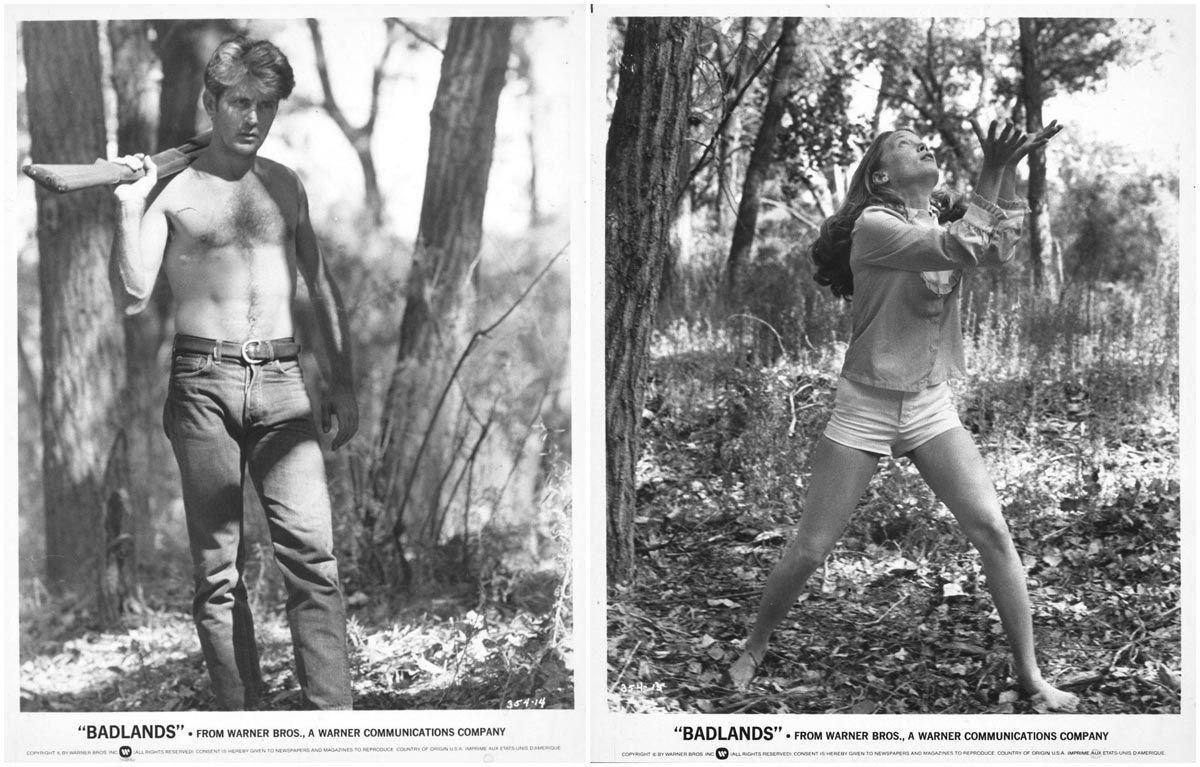
That ache is what feels layered inside me. It’s wrapped up in a powerful memory. So did I see it at 13? It doesn’t matter – I feel like I saw Warren Oates painting that big sign with all of those big fat clouds in the blue sky, I feel like I remember him shooting Holly’s dog, I feel like I remember Kit running through that Swiss Family Robinson-like fort and sleeping under that Maxfield Parrish painting swiped from the dad’s house, I feel like I remember the two dancing to “Love is Strange,” Holly barefoot, Kit in boots, and I feel like I remember Holly sitting in the car with Kit reading that movie magazine: “Rumor: Frank Sinatra and Rita Hayworth are in love. Fact: True. But not with each other.”
I’ve now seen Malick’s first film, a masterpiece, so many times that it’s permanently embedded in my brain and it twists inside my grey matter with images and impressions from countless viewings, including my own unreliable recollection at 13. The movie is so special, so enchanted, so truly transcendent that it clings to your very soul, a palimpsest on the brain. If that sounds hyperbolic, so be it. But the moment I hear Carl Orff’s “Gassenhauer” in the movie, or anywhere, I get goosebumps. Sometimes I want to cry. The way it starts out quietly, delicately, and then builds and builds, the drums moving towards that crescendo, it feels like the most dramatic music box a little girl ever opened – timorous innocence becoming stronger and more confident. Faded adolescent memories come to me in brighter detail, full of hope and promise and sadness and those first feelings of falling in love. And then, growing up and realizing that person isn’t what you built them up to be in your fevered adolescent brain (or your adult brain). You, yourself, are an unreliable narrator, just as Holly is in Badlands.
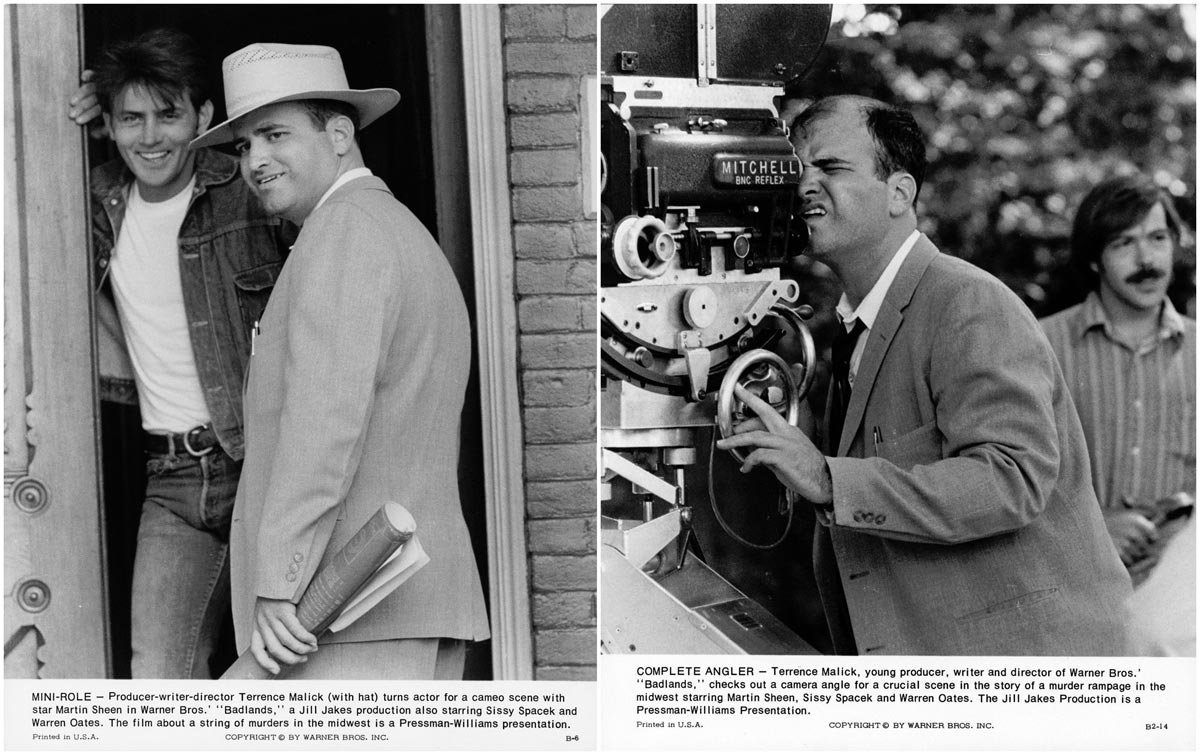
Part of Malick’s brilliance lies in the way the picture is narrated by Spacek’s little 15-year-old girl who, at times, seems both younger than her years and older – a girl who, from the outset, is estranged from her father (“He tried to act cheerful, but he could never be consoled by the little stranger he found in his house,” she narrates). Her dad (Oates, so weirdly beautiful here, both fearsome father and broken-hearted widower who kept his wedding cake in the freezer for ten years) forbids her to see the local bad boy, 25-year-old Kit, a garbage collector who is fired from his job and who puffs himself up in a world that doesn’t give a shit about him. He’s a cool young man, gorgeous in his 1950’s blue jeans, but he doesn’t seem to fool others with his big talk. He can fool a teenager, however. Holly recalls he “was handsomer than anybody I’d ever met. He looked just like James Dean.” That would be quite something for a shy girl who believes she lacks personality, a girl simply twirling her baton in those white shorts on the lawn. And then this boy comes along, changing her fate forever. She likes that he appreciates her mind, and not just sex. They fall in love, they bond on a deeper level. Only, we never really see them discuss deeper ideas about life, we just get glimpses of their worldview on the periphery of events – like when Holly feels guilty for throwing out that sick catfish. She confides in Kit who tells her he does stuff like this too, and that some of his behavior would be considered strange. We then watch him stand on a dead cow in the feedlot. A catfish in the yard isn’t so weird; it’s something a confused teenager would do if she were fearful of witnessing death. Maybe she has good reasons to fear death – her mother died, her father shoots her dog dead for seeing Kit behind his back, and what if she died a virgin? She doesn’t want to die. Kit seems less concerned about death. He just wants to be somebody. He wants to leave a mark. And he does. He’s finally given some respect and certainly celebrity when he’s caught. And in the end, chained up and chatting up the authorities, throwing out keepsakes to the law so they’ll remember him, he seems, finally, even happy.
We don’t know how much of Holly’s sometimes florid recollections are a true representation of how she feels; about the brutal events on their crime spree. Though I do believe her reveries – I believe them in terms of how she wants to feel at the time, or how she wants to remember them at the time. But her romantic notions turn into tedium and annoyance towards Kit, even a wish he’d die. The rush of teen love is always dramatic, and so when Holly says: “In the stench and slime of the feedlot, he’d remember how I looked the night before, how I ran my hand through his hair and traced the outline of his lips with my fingertip. He wanted to die with me, and I dreamed of being lost forever in his arms.” You don’t doubt her. But you also watch their scenes together and observe them talk about banal things, like garbage on the street, or a tree falling in the water; Kit records a series of bromides on the Dictaphone when they take a break holed up in the rich man’s house they’re holding hostage. Holly seems joyful and attracted but sometimes, disappointed and irritated. When they finally have sex she asks: “Is that all there is to it? Gosh, what was everybody talking about?” Kit answers, “Don’t ask me.”
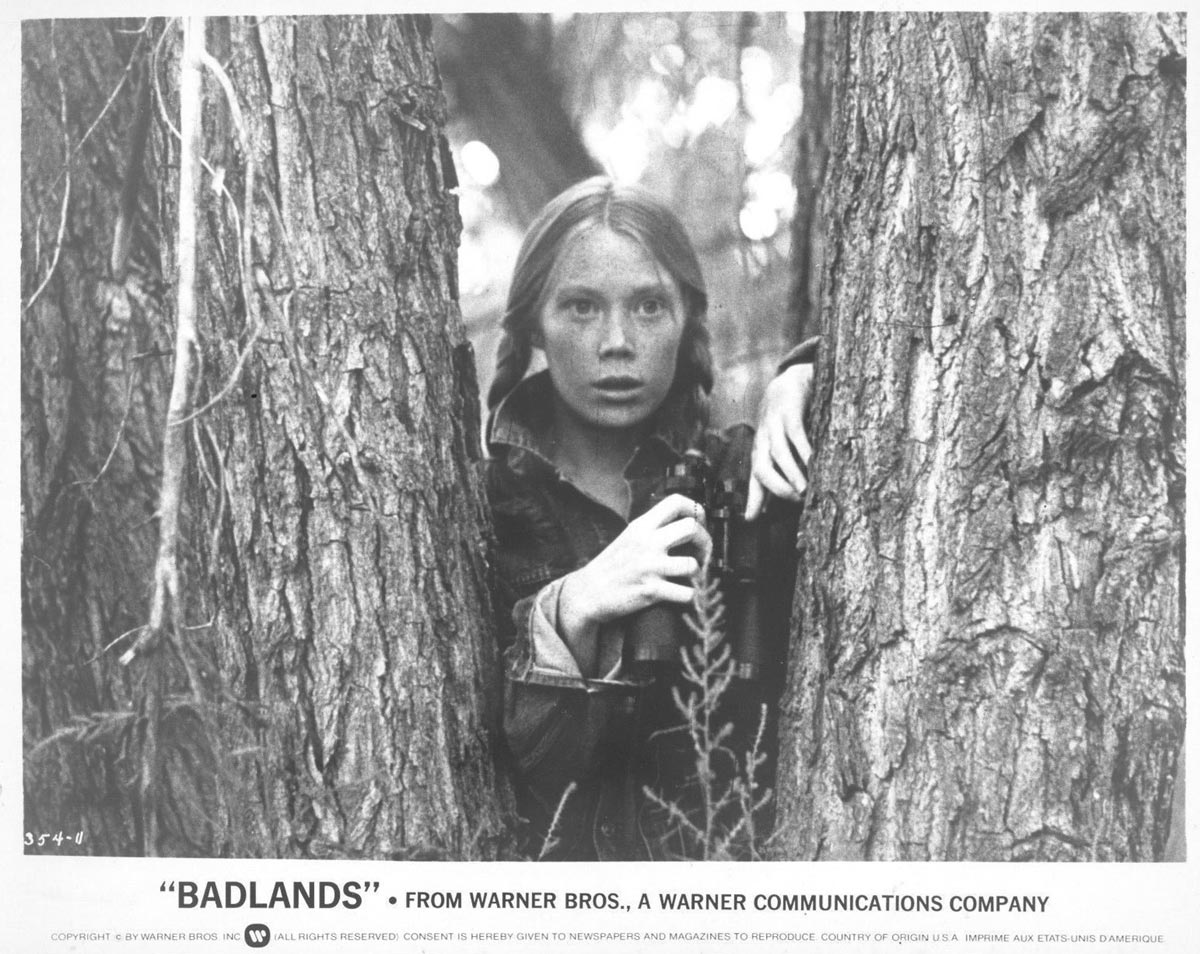
The stench and slime of the feedlot seems how Kit views the world outside of Holly – and he craves glamour and respect. He likes to leave markers with rocks, or bury personal items either for the purpose of returning to (which won’t happen) or for others to discover. Holly intones: “He said that nobody else would know where we’d put them, and that we’d come back someday, maybe, and they’d still be sitting here, just the same, but we’d be different. And if we never got back, well, somebody might dig them up a thousand years from now and wouldn’t they wonder!” Wouldn’t they. The need to feel, not only alive, but for others to know that you were alive, runs throughout the movie – Kit and Holly creating their own pictures and movies through both romance and heinous acts. Kit knows it will mean something and as he speeds from the law near the end, he fixes the rearview mirror to look at himself. It’s got to at least look good. Creating an idyllic world is an escape from the junk of life; a need to transcend regular existence, so taking in the picture’s glory of nature, we feel like we could always escape day-to-day banalities if we tried. Holly observes nature, loving the “cooing of the doves and the hum of dragonflies… the air made it always seem lonesome and like everybody’s dead and gone.” Kit wants more; he’s searching for some fabled kingdom. As Holly narrates: “We took off at sunset, on a line toward the mountains of Saskatchewan, for Kit a magical land beyond the reach of the law.” That magical land is . . . where? It’s either everywhere, in moments, if you really appreciate nature, or, in Kit’s case, in his death, when he’ll be so mythologized that songs will be written and movies will be made about him. Malick understands this eternal desire. Not to be famous, but to be remembered, not to remain specks of dust in such an enormous world.
The movie pulls you in different directions, the way those thoughts that riddle your sleep do when you’re young. The road, the music, the period detail that’s more timeless than stuck in an era; more a dark fairy tale rather than a 1950’s story, the rapturous American landscape and bittersweet romance led by characters who could almost be viewed as ciphers, and yet, they’re not. Their remoteness is not so distant that you can’t feel for them, in spite of yourself. They’re even quite funny, in an understated way. Because Sheen and Spacek are so perfectly cast and they play their characters so inscrutably innocent, and yet, so blasé and scary, not one scene between them rings obvious or absurdly psycho; like they’re yearning to tell us something or reaching out to us for help. After watching a man bleed to death, a heartbreaking scene, Holly narrates: “At this moment, I didn’t feel shame or fear, but just kind of blah, like when you’re sitting there and all the water’s run out of the bathtub.” Malick doesn’t moralize or explain and even Holly’s voiceovers inform very little about the depth of their problems. But you see the bloom fall off the rose: “We had our bad moments, like any couple. Kit accused me of only being along for the ride, while at times I wished he’d fall in the river and drown, so I could watch.”
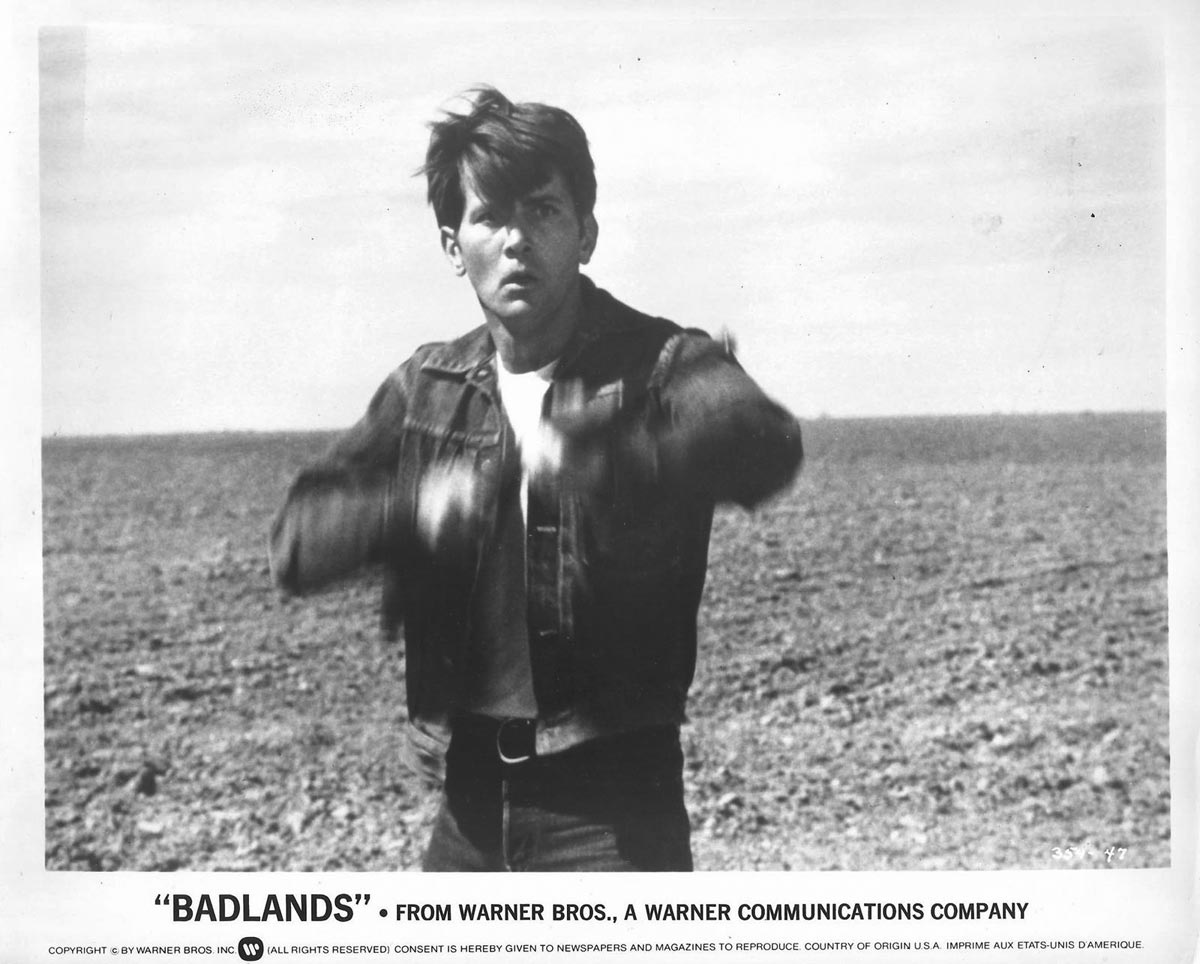
Malick’s debut is one of the most extraordinary first films in all of cinema – he was working an alchemy and a genius that felt otherworldly (something he’d continue in subsequent pictures, Badlands remains my favorite). The film, as I’ve made obvious here, became an obsession for me. Its poetic understanding of the intense, alienated teen; their extreme impulses, but also their mystery and banality, how that understanding is wrapped in our own mythos, moves me in mysterious ways. One of my favorite moments is during Kit and Holly’s long drive through the Great Plains, where their isolation matches the spare landscape – the enormous sky and almost unsettlingly magnificent sunsets. Amidst all of this cinematic gorgeousness, their long and bloody road trip is turning. Holly is weary and wary of living out of the car. They live like animals, she thinks, and she’s becoming wiser as she pictures her ill-fated future with Kit. But, then, there’s that moment, that sublimely beautiful moment: In the black of night, with only the car lights illuminating the darkness, they dance to Nat King Cole’s “A Blossom Fell” from the tinny car radio. Holly may not even be enjoying this moment, but we are as we watch them together. Kit says, “Boy, if I could sing a song like that, I mean, if I could sing a song about the way I feel right now, it’d be a hit.”
Badlands affected me and still affects me and continues to give me chills. And it runs through my mind almost as my own memory, tapping into something primal and wistful and musical – that youthful feeling of the new, influential and forbidden. And then losing that feeling. Badlands haunted me in my sleepless half-awake young self, and I’ll stick to that evocation even if I’m not sure of the exact age. My own memories with the movie and the memories and images of the movie itself, what Malick was meditating on, echo what Carson McCullers wrote about wistfulness; things we long for but can never really attain: “We are torn between nostalgia for the familiar and an urge for the foreign and strange. As often as not, we are homesick most for the places we have never known.”
